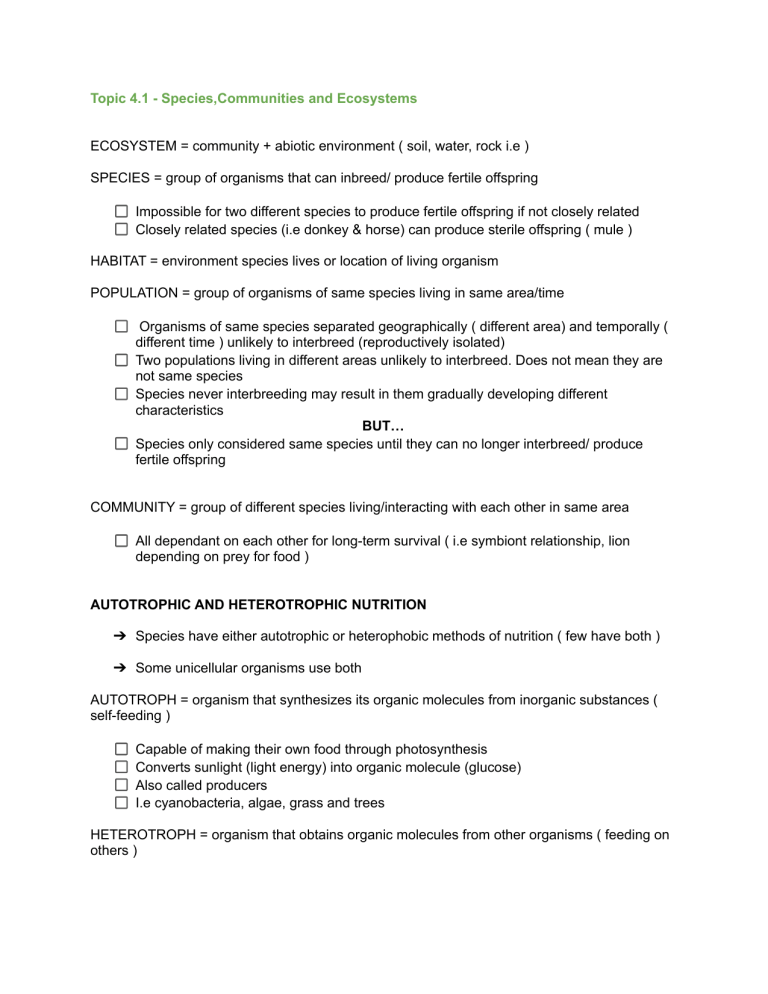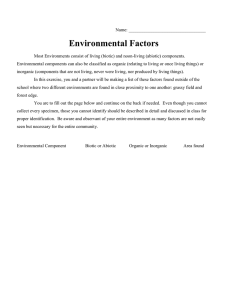
Topic 4.1 - Species,Communities and Ecosystems ECOSYSTEM = community + abiotic environment ( soil, water, rock i.e ) SPECIES = group of organisms that can inbreed/ produce fertile offspring Impossible for two different species to produce fertile offspring if not closely related Closely related species (i.e donkey & horse) can produce sterile offspring ( mule ) HABITAT = environment species lives or location of living organism POPULATION = group of organisms of same species living in same area/time Organisms of same species separated geographically ( different area) and temporally ( different time ) unlikely to interbreed (reproductively isolated) Two populations living in different areas unlikely to interbreed. Does not mean they are not same species Species never interbreeding may result in them gradually developing different characteristics BUT… Species only considered same species until they can no longer interbreed/ produce fertile offspring COMMUNITY = group of different species living/interacting with each other in same area All dependant on each other for long-term survival ( i.e symbiont relationship, lion depending on prey for food ) AUTOTROPHIC AND HETEROTROPHIC NUTRITION ➔ Species have either autotrophic or heterophobic methods of nutrition ( few have both ) ➔ Some unicellular organisms use both AUTOTROPH = organism that synthesizes its organic molecules from inorganic substances ( self-feeding ) Capable of making their own food through photosynthesis Converts sunlight (light energy) into organic molecule (glucose) Also called producers I.e cyanobacteria, algae, grass and trees HETEROTROPH = organism that obtains organic molecules from other organisms ( feeding on others ) MIXOTROPH = organism that uses both methods of nutrition ( self-feeding and feeding on others) NATURE OF SCIENCE: TRENDS IN PLANT AND ALGAL NUTRITION ● ● ● ● Most plants/algae are autotrophic Majority make own organic compounds (glucose) through photosynthesis in chloroplasts Plants that do not have chloroplasts/do not perform photosynthesis ( Only 1%) = parsitic Original species believed to be autotrophic and parasitic species evolved from them CONSUMERS = heterotroph that feeds on living organisms by ingestion ● ● ● Heterotrophs cannot make own organic matter ∴obtain organic molecules from other organisms Rely on organism (either alive or dead/decomposing) for food Use range of different food sources/feeding mechanisms HERBIVORES ( i.e zebra, deer ) feed on producers (plants) ↓ OMNIVORES ( e.g mouse, chimp ) feed on combination ( both producers & consumers ) ↓ CARNIVORES ( e.g lions, snakes ) feed on other consumers ↓ SCAVENGERS = specialized carnivores, feed on mostly dead/decaying animals (e.g hyenas,vultures, crows) Consumers divided into trophic groups according to what they eat: PRIMARY CONSUMERS feed on AUTOTROPHS SECONDARY CONSUMERS feed on PRIMARY CONSUMERS DETRITIVORES and SAPROTROPHS DETRITIVORE = heterotrophic organism that ingests non-living (dead) organic matter by internal digestion ● ● ● Ingest organic matter ( i.e dead leaves, other plant parts, feces, or animal carcasses) Digest it internally absorbing productions of digestion I.e earthworms, woolice, dung beetles, bottom feeders in rivers & oceans SAPROTROPH = heterotrophic organism that lives on/or in non-living ( dead) organic matter, secreting digestive enzymes into it and absorbing products of digestion ● ● ● ● Unlike heterotroph, they are not consumers/ do not ingest food Important in role of decay of dead organic materials Also called decomposers (they help break down waste materials & release elements such as nitrogen into ecosystem to be used by other organisms) i.e fungi & bacteria SKILL: IDENTIFYING MODES OF NUTRIENT Either ingests organic matter ( no cell walls) or by taking it into guts CONSUMERS Feeding on living/recently killed organism DETRITIVORES Feeding on dead organic matter Cell wall present. No ingestion of organic matter. No gut INORGANIC NUTRIENTS ● ● ● inorganic molecules = carbon,hydrogen, oxygen,nitrogen,phosphorus & others, heterotroph/autotroph obtain from abiotic environment Autotroph obtain elements they need from abiotic environment i.e carbon & nitrogen Heterotrophs obtain some elements from carbon compound in food/others from abiotic environment i.e sodium,potassium & calcium NUTRIENT CYCLES ● ● ● ● ● Limited supply of nutrients on earth Inorganic nutrients maintained by nutrient cycling Organisms absorb needed elements as inorganic nutrients, use them and return them to environment Autotrophs convert nutrients from inorganic to organic molecules i.e CO2 →glucose Heterotrophs ingest other organisms, gain energy & release nutrients back into soil to ensure availability to other organisms SUSTAINABIlTY OF ECOSYSTEM ● ● Relatively little energy & nutrients flows enter/or leave ecosystems Ecosystems = self-contained & self-sustaining ● Requirements for sustainability of ecosystem: ○ Nutrient availability ( saprotroph crucial for continuous provision of nutrients) ○ Detoxification of waste products( e.g decomposing bacteria derive energy from breakdown of toxic molecules into simpler, less toxic substances) ○ Energy availability ( light form = sun) Nutrients can be recycled indefinitely, no lack of chemical elements Energy cannot be recycled, depends on continuous supply of energy from Sun ● ● MESOCOSMS ● ● ● Biological systems with features of abiotic/biotic environment Restricted in size & under controlled conditions Used for scientific research/to collect data



